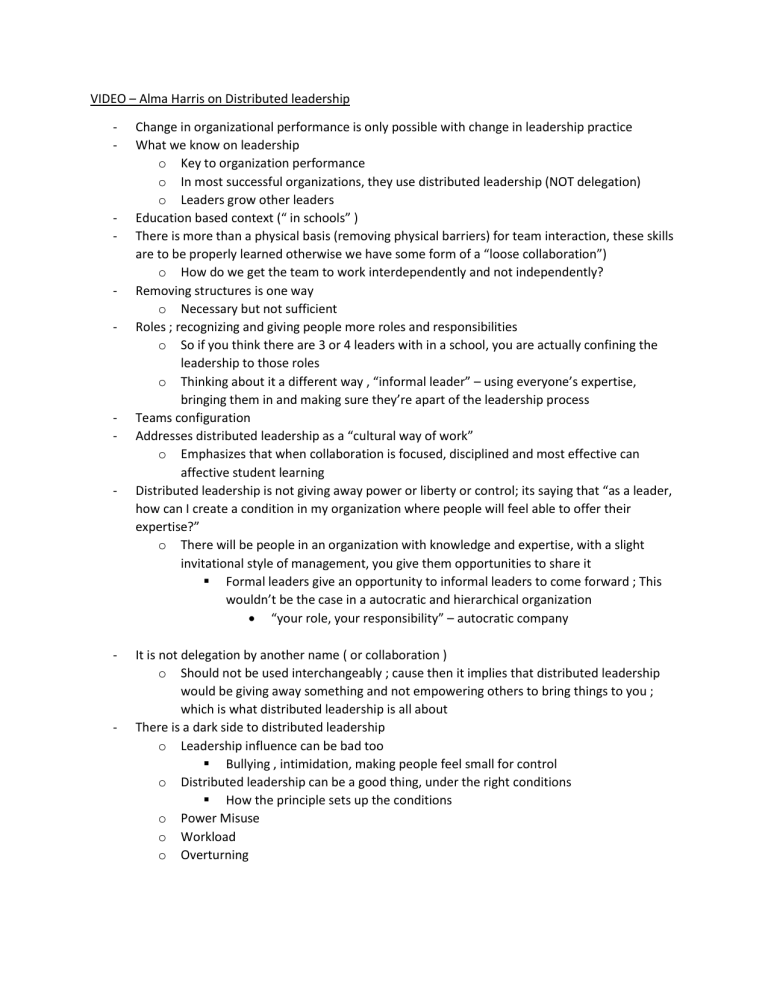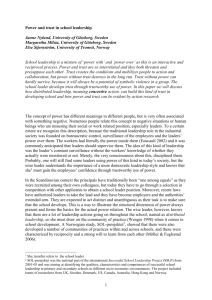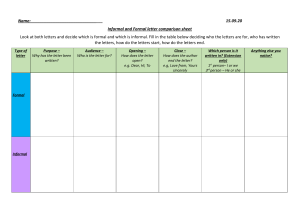
VIDEO – Alma Harris on Distributed leadership - - - - - - - Change in organizational performance is only possible with change in leadership practice What we know on leadership o Key to organization performance o In most successful organizations, they use distributed leadership (NOT delegation) o Leaders grow other leaders Education based context (“ in schools” ) There is more than a physical basis (removing physical barriers) for team interaction, these skills are to be properly learned otherwise we have some form of a “loose collaboration”) o How do we get the team to work interdependently and not independently? Removing structures is one way o Necessary but not sufficient Roles ; recognizing and giving people more roles and responsibilities o So if you think there are 3 or 4 leaders with in a school, you are actually confining the leadership to those roles o Thinking about it a different way , “informal leader” – using everyone’s expertise, bringing them in and making sure they’re apart of the leadership process Teams configuration Addresses distributed leadership as a “cultural way of work” o Emphasizes that when collaboration is focused, disciplined and most effective can affective student learning Distributed leadership is not giving away power or liberty or control; its saying that “as a leader, how can I create a condition in my organization where people will feel able to offer their expertise?” o There will be people in an organization with knowledge and expertise, with a slight invitational style of management, you give them opportunities to share it Formal leaders give an opportunity to informal leaders to come forward ; This wouldn’t be the case in a autocratic and hierarchical organization “your role, your responsibility” – autocratic company It is not delegation by another name ( or collaboration ) o Should not be used interchangeably ; cause then it implies that distributed leadership would be giving away something and not empowering others to bring things to you ; which is what distributed leadership is all about There is a dark side to distributed leadership o Leadership influence can be bad too Bullying , intimidation, making people feel small for control o Distributed leadership can be a good thing, under the right conditions How the principle sets up the conditions o Power Misuse o Workload o Overturning OPTIONAL FURTHER READING Distributed Leadership in Organizations (Bolden) - - Talks about Peter Gronn o Says he outlined the idea of DL as a possible solution te seeing leadership as a one way street between One leader and his followers (‘two opposing camps’) to Those that see it as a result of individual agency (Bass, 1985 *) As a result of system designs and role structures (Jacques, 1989) Says that DL has become a ‘post heroic’ representation that centered in on the idea of focusing on a systemic perspective, where leadership is a collective social process. o Individuals contribute to a group and not where something is done by one person to others PETER GRONN ARGUMENT - - A holistic sense instead of an aggregation of individual contribution Reffered to as “concertive action” (opposed to numerical action) 3 alternative forms of engagement ( ‘spontaneous collaboration’ , ‘intuvitive working relationships’ , ‘institutionalized practices’ ) Called for a necessary reframing of the leadership model o It is fluid and emergent rather than fixed SPILLANE AND DIAMOND ARGUMENT : SITUATED LEADERSHIP PRACTICES - - Distributed perspective has 2 aspects o Leader + ; acknowledges all the people that have put in their 2 cents to the leadership and management practice as opposed to those in formally designated leadership roles. o Practice ; states that leading and managing is a product of interactions of school leaders, followers and aspects of their situation Apparently, these aspects together offer an analytical framework for examining the day to day practice of leadership and management instead of focusing on leadership structures. Shared leadership – other pov (???) - - aka collaborative leadership , co – leadership and emergent leadership o idea is to discard the monopoly and suggesting a similar need for more collective and systematic understanding of leadership – and seen as a social process. Check paper for citation THEORETICAL ORIGINS - Gibb (1954) o Proposed that leadership is best seen as a group quality and as a set of functions which must be carried out said group o Helped Gronn form a distinction between numerical and concertive action - - - “ multiplicity and pattern of group functions performed” and overall numerical frequency of the acts done by the group Brown and Hosking (1986) o Apparently responsible for its resurrection – maybe due a growing appetite for ‘new leadership’ based on transformational and charismatic leadership o Didn’t really contribute much (???) but paved way for more research Spillane (2004) o ‘distributed cognition’ and ‘activity theory’ (backed up by Gronn (2000)) Represents human cognition and experience as integrally bound up with the physical, social and cultural context in which it occurs. Engestrom (1999) (Gronn based his framework on his work) o Offers a framework for analyzing situated activity as the product of reciprocal and mediated interactions between Instruments Subjects Objects Rules Community Division of labour “ Gronn (2008a) however, also cites the significance of a stream of additional theory and research, such as Mary Parker Follett’s (1942/2003) work on reciprocal influence; Benne and Sheats (1948) work on the diffusion of leadership functions within groups; Gibb’s (1954) work on leadership; French and Snyder’s (1959) and Dahl’s (1961) work on the distribution of power and influence; Becker and Useem’s (1942) and Etzioni’s (1965) work on dual leadership; Kerr and Jermier’s (1978) work on substitutes for leadership; Katz and Kahn’s (1966, 1978) work on sharing leadership; and Schein (1988) on the functions of leadership. In addition to these sources Harris (2009) cites the work of Festinger et al. (1950) and Heinicke and Bales’ (1953) on informal leadership in groups and teams; Barnard (1968) on the functions of the executive and the informal organisation; Manz and Sims’ (1993) social learning theory; Hutchins’ (1995) work on distributed cognition and ‘lateral agency’; Louis and Marks’ (1998) work on professional learning communities; and Wheatley’s (1994) work on complexity and systems. Finally, Leithwood et al. (2009b) highlight the significance of organizational learning theory (Weick and Roberts, 1993, Hutchins, 1995); distributed cognition (Salomon, 1993, Jermier and Kerr, 1997, Perkins, 1993); complexity science (see Uhl-Bien et al., 2007, and Osborn and Hunt, 2007 for a review); and ‘high involvement leadership’ (see Yukl, 2002). “ - Look up these names and articles RELATED CONCEPTS - Explore these connections o Descriptive approach to DL – analytical framework which assess how the leadership is distributed (Spillane and Diamond,(2000)) o Democratic deficit – within manifestations of DL in schools ; where they stop advocating for principles of self governance and concepts that form the basis of democracy based on measures like efficiency and effectiveness. o Differences between delegated , democratic and dispersed leadership o Shared Leadership o ‘vertical’ and ‘horizontal’ leadership The paper continues to talk on the results on the application of DL along with what impacts its application and the context of distributed leadership. Distributed Leadership and Bureaucracy (Lumby) - - Talks about bureaucracy and power first Distributed Leadership o Says its definition is ‘problematic’; because of its divided path in history ; between a research framework to understand the totality of leadership practice in an organization, including both formal and informal, planned and emergent activity ; to become a particular practice of leadership. A characteristic claim of distributed leadership is that it diminishes the power of the solo leader, enabling others also to take a leadership role. o Uses example by Murphy et al. (2009) o In a longitudinal study of six schools, Murphy et al. accuse current structures of failing to meet the needs of learners and of inhibiting change, in general, and shared leadership, in particular. They argue that new structures are needed. One example given of such changed structures to accommodate shared leadership is an adjustment in timetabling that enabled staff to come together to discuss and plan work. However, the resulting meetings appeared to be rather ineffective until ‘the principal tapped someone to act as the informal leader for the various groups’ (Murphy et al., 2009: 189). The principal also provided protocols and a booklet in which to record the activity of the meetings. ‘Halfway through the year, she actually collected those notebooks and took a look at them ... [to] make sure people were doing the work’ (Murphy et al., 2009: 189). This looks remarkably like the principal in a formal authority role continuing to select leaders, delegating work and shaping the parameters within which they function. Power remains largely unaltered. o - This is but one of various accounts of a school or university asserting that it is using distributed leadership, when the evidence suggests that power relations remain undisturbed Cryss Brunner’s work with female leaders in schools also uncovered a paradox. In apparently giving away power to others, you increase your own. One of the women professionals explained that ‘by enabling your people and improving your people you really give yourself a power’ (Brunner, 2000: 145). o Equally, some believed that the explicit use of power as domination served to rob one of power. Some women in the study felt intensely uncomfortable discussing power, preferring to refer to leadership. These findings are evident in other education sectors, such as universities, and are true of men as well as women



